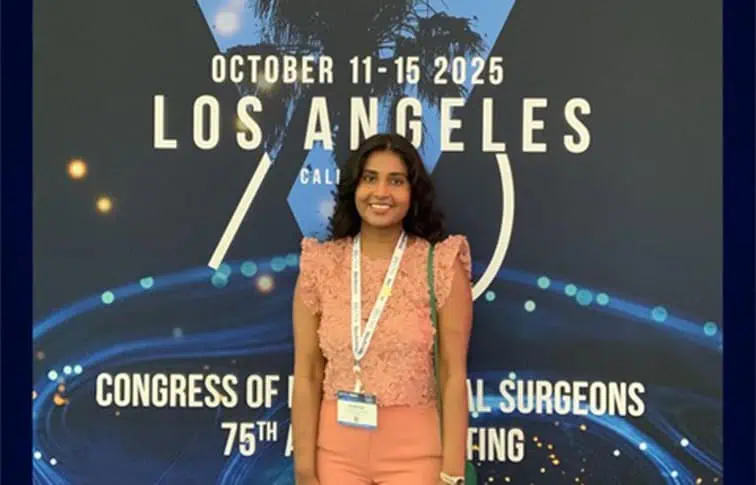Dr Vijidha Shree Rajkumar presented new research at the Congress of Neurological Surgeons 2025 in Los Angeles.

At the Congress of Neurological Surgeons (CNS) 2025 in Los Angeles, Dr Vijidha Shree Rajkumar, from O Spine Sydney, The University of Sydney, and Sydney Adventist Hospital, presented new clinical data reinforcing the safety, efficacy, and surgical versatility of prone lateral interbody fusion (PTP) for managing degenerative lumbar pathology, supported by ATEC Spine. Her research, co-authored with Professor Brian Owler and Dr Yi Yuen Wang, adds to the growing body of evidence supporting minimally invasive, single-position spinal procedures for improved patient outcomes.
Prone lateral fusion (PTP) represents a modern approach to spinal surgery, allowing anterior access to the lumbar spine while maintaining the patient in the prone position. This technique eliminates the need for patient repositioning, streamlining operating room workflow and reducing anaesthetic time.
Dr Rajkumar’s multi-centre prospective cohort study evaluated 204 patients (108 female, 96 male) who underwent PTP fusion for various degenerative lumbar conditions, including spondylolisthesis and lumbar deformity. The research aimed to assess both radiological improvements and perioperative safety across multiple centres and surgical teams.
Across 282 interbody fusions (L1/2 to L4/5), the study demonstrated statistically significant improvements in spinal alignment:
Importantly, no major vascular or visceral complications were recorded. Minor complications included four cases of prolonged psoas weakness, two surgical-site infections, one psoas haematoma, and two re-operations for fracture or implant repositioning.
Dr Rajkumar noted that these findings support prone lateral fusion as a validated and safe technique, particularly for elderly patients with degenerative spine disorders, delivering both radiographic and functional benefits while maintaining low morbidity rates.
In a companion study presented at CNS 2025, Dr Rajkumar explored whether surgical outcomes differ when accessing the spine from the left or right side during prone lateral fusion. This comparative outcome study analysed 178 fusions (87 left, 91 right) performed between July 2022 and March 2025 .
The data showed no statistically significant differences in operative metrics between approaches, including anaesthetic time (208 vs 212 minutes), operative time (147 vs 145 minutes), blood loss, or complication rates. Both sides recorded a low complication rate of 3.9%, with only one infection, one implant-related reoperation, and one anterior longitudinal ligament release per group.
These results challenge the long-standing surgical preference for the left-sided approach, confirming that the right-sided approach is equally safe and effective. Dr Rajkumar’s work, therefore, provides surgeons greater flexibility in approach selection based on patient anatomy and surgical planning.
The combined findings from these two studies mark a pivotal moment in the evolution of single-position spine surgery. By demonstrating that prone lateral fusion not only achieves strong biomechanical correction but also offers consistent outcomes across different approach sides, this research supports greater procedural confidence and standardisation among spinal surgeons globally.
Dr Rajkumar’s contribution underscores a broader trend toward precision-guided, minimally invasive spine surgery, aligning with CNS 2025’s overarching theme of innovation in motion.
These studies were conducted in collaboration with The University of Sydney, Sydney Adventist Hospital, and O Spine Sydney, under the supervision of Professor Brian Owler. The research highlights Australia’s active role in advancing neurosurgical innovation and global knowledge exchange through the Congress of Neurological Surgeons.